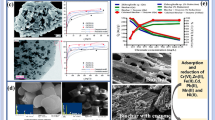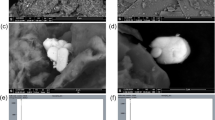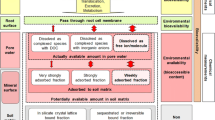Abstract
Cesium's enhanced bioavailability in contaminated wetlands onthe U.S. Department of Energy's Savannah River Site (SRS) is thoughtto be due to the low clay fraction of SRS soils, and that the clay mineralogyis dominated by kaolinites. Remediation of the wetlands is problematic becausecurrent technologies are destructive to the sensitive ecosystems. We tested11 clay minerals (two micas, a vermiculite, six illites, a kaolinite, anda smectite) for their propensity to sorb and retain 137Cs. Twominerals were subsequently chosen as candidates for in situ remediation amendmentmaterials because they had 137Cs distribution coefficients (K d) well in excess of 10,000 ml . g –1 , and desorbed less than 20% ofthe Cs when mixed in a 0.1M NH 4 Cl solution. Incremental additions of thecandidate minerals to 137Cs-contaminated sediments appreciablyintercepted and retained desorbed 137Cs in the presence of highlevels of NH4 . Implications for using the minerals as a nondestructive,in situ remediation technique are discussed.
Similar content being viewed by others
References
H. Carlton, L. R. Bauer, A. B. Evans, L. A. Beary, C. E. Murphy, Jr., J. E. Pinder, III, R. N. Strom, Westinghouse Savannah River Company Report WSRC-RP-92–250, Aiken, SC, 1992.
F. W. Whicker, T. G. Hinton, D. J. Niquette, J. Seel, in: ER'93: Environmental Remediation Conference, U.S. Dept. of Energy, Augusta, GA, 1993, p. 619.
T. G. Hinton, C. M. Bell, F. W. Whicker, T. Philippi, J. Environ. Rad., 44 (1999) 1.
C. W. Francis, F. S. Brinkley, Nature, 260 (1976) 511.
D. W. Evans, J. J. Alberts, R. A. Clark, III, Geochim. Cosmochim. Acta, 47 (1983) 1041.
G. W. Kunze, J. B. Dixon, Methods of Soil Analysis, Part 1, Physical and Mineralogical Methods, 2nd ed., A. Klute (Ed.), American Society of Agronomy, Inc., Madison, WI, 1986.
J. Neter, W. Wasserman, Applied Linear Statistical Models, Richard D. Irwin, Inc., Homewood, IL, 1974.
D. S. Fanning, V. Z. Keramidas, M. A. El-Desoky, Minerals in Soil Environments, 2nd ed., J. B. DIXON and S. B. Weed (Eds), Soil Sci. Soc. Am. Book Ser. 1, Madison, WI, 1989, p. 551.
S. W. BAILEY (Ed.), Reviews in Mineralogy, Vol. 13, Mineralogical Soc. of Am., Washington, D.C., 1984, p. 1.
T. G. Hinton, D. I. Kaplan, A. C. Knox, S. M. Serkiz, Westinghouse Savannah River Company Report WSRC-TC-99–00229, Aiken, SC, 1999.
Author information
Authors and Affiliations
Rights and permissions
About this article
Cite this article
Serkiz, S. An in situ method for remediating 137Cs-contaminated wetlands using naturally occurring minerals. Journal of Radioanalytical and Nuclear Chemistry 249, 197–202 (2001). https://doi.org/10.1023/A:1013234309124
Issue Date:
DOI: https://doi.org/10.1023/A:1013234309124




